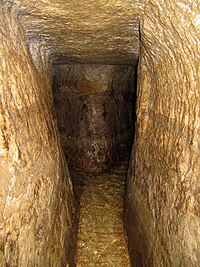AY Honors/Engineering/Answer Key
Engineering
Approval authority:
Category:
Skill Level:
Year of Introduction:
![]()
Contents
|
This Honor is a component of the Modern Technology Master Award. |
1. What is engineering?
Engineering is the study and practical application of science, economics, math, and practical knowledge to solve the issues of society.
2. Define the following four branches of engineering.
- Chemical Engineering
- focuses on processes from applied sciences (chemistry, physics, biology, microbiology, and biochemistry) that convert raw materials of chemicals into more useful forms.
- Electrical Engineering
- focuses on the study of electricity, electronics, and electromagnetism and its uses related to designing, testing, and manufacturing electrical equipment.
- Civil Engineering
- focuses on sciences that involve the design, construction, and maintenance of structures such as bridges, buildings, and tunnels. It also includes roads and underground utilities like water, sanitary sewer, storm sewer, natural gas etc.
- Mechanical Engineering
- focuses on the usage of heat and mechanical power as a power source for machines and mechanical systems.
3. Identify and define at least 15 additional disciplines of engineering.
- Aerospace Engineering
- Optical Engineering
- Computer Engineering
- Material Engineering
- Process Engineering
- Environmental Engineering
- Structural Engineering
- Power Engineering
- Acoustical Engineering
- Transport Engineering
- Nuclear Engineering
- Industrial Engineering
- Biological Engineering
- Textile Engineering
- Energy Engineering
4. Explain the general responsibilities of an engineer.
An engineer is a highly regarded professional that focuses on solving problems of society on a larger scale through design and analysis. This is primarily accomplished by applying their in depth knowledge of the sciences, mathematics, as well as their gift of critical thinking into practical use for the benefit of society.
Engineers are often tasked with developing ways to accomplish similar task, but with more cost effective approaches, stronger and lighter materials, and streamlined and updated resources.
5. Discuss what type education is required for a career in engineering.
At minimum, an undergraduate degree is required in order to begin a successful path as an engineer in any field. Due to the number of engineering fields, each discipline focuses on specific coursework. As such, a strong science oriented and mathematical background is required. This may include substantial coursework in biology, physics, advanced math, life sciences, or chemistry, just to name a few.
6. How has the discipline of engineering contributed to society?
Engineers are responsible in some way for all of the structures that have been designed and built. Engineers are tasked with finding better ways to make everything work; whether it be electrical, biological, or civil. Buildings, automobile engine blocks, airplanes, bridges, tunnels, dams, and computers are all designed in some way by one or more engineering disciplines.
Engineers have also contributed to the productivity and quality of various industries; including but not limited to the food industry, natural resource exploration, and manufacturing.
7. On your own or with a group, develop a chart board that outlines a brief history of a famous engineer, highlighting their contributions to society. Prepare and give an oral presentation on your findings.
This requirement is designed for a candidate to research a famous engineer. Any engineer that is famous likely designed a famous building, bridge, or something else that has made an impact to society.
Don't confuse an engineer with a scientist, though there are definite similarities and overlaps. Here is how the Edson Tech Center differentiates the two fields:
The emphasis in this Hall of Fame is on engineers and experimental scientists who invented patentable devices or who made key discoveries that led to their development. Our Hall of Fame does not cover "scientists" but those who built and tinkered invention. Our list includes Mechanical, Chemical, and Electrical Engineers. Many of them worked for Westinghouse, General Electric, Western Electric and AT&T." http://www.edisontechcenter.org/HallofFame.html
A list of great achievements by field. http://www.greatachievements.org/
20 of the greatest engineers of all time: http://onlineengineeringprograms.org/2011/the-20-most-notable-engineers-of-all-time/
8. Read Genesis 6. Discuss the biblical context of this chapter drawing comparisons to the field of engineering.
The first biblical account of an engineering project is outlined in Genesis 6. Due to the sinful nature of man, the Lord declared that He will bring a flood to cleanse the earth. As a result, Noah was given specific instructions to construct an ark. Similar to any engineering project, the Lord outlined the details of the raw materials, dimensions, and layout to construct the ark.
9. Identify 4 specific biblical engineering marvels that illustrate the art and importance of engineering.
- Building of the Pyramids and the treasure cities of Egypt (Exodus 1)
- Building the Tower of Babel (Genesis 11)
- Construction of Noah's ark (Genesis 6)
- Building of the Sanctuary, (Exodus 25 and on)
- Building Solomon's Temple (1 Kings 6)
- Rebuilding the walls of Jerusalem with Nehemiah. (the theme of the book of Nehemiah)
- Hezekiah's tunnel (2 Kings 20:20 and check for photos and info online since this engineering marvel has been rediscovered) See W:Siloam_tunnel as a start

 A drawing of the tunnel and its features, and a photo of inside the tunnel.
A drawing of the tunnel and its features, and a photo of inside the tunnel.
10. Define the following terms as it relates to the engineering discipline:
- CAD (Computer Aided Design)
- is a 2D and 3D special computer type software that offers powerful designing capability. It is regularly used by engineers, architects, designers, inventors, and mechanics.
- Simulation
- is a technique that allows engineers to justify selected equipment necessary to address projects in their early stages of development. Equipment such as software, computers, and machinery can simulate a designed process, thus allowing engineers to select the best solutions to their issues.
- Rendering
- is the ability to render 2D or 3D scenes from CAD designs. A type of software with rendering ability allows engineers and designers to quickly develop 3D scenes using this method.
- Steady State
- is a term that can have multiple meanings depending on the engineering discipline in question.
- Electrical Engineering
- the ability for a machine powered by electricity to regain its original powered state.
- Mechanical Engineering
- the ability to regain stability after a force is applied.
- Constraint
- is a term used to describe preset limitations. They can be based on any combination of the following: cost, safety concerns, reliability, environmental impact, or any concern that can impact the completion of a project according to predetermined standards. An engineering constraint might be that a bridge has to support a fully loaded truck, or the building must withstand a 7.0 earthquake to be approved by the city.
11. What is reverse engineering?
Reverse engineering is the process of learning software or how a machine functions without prior documentation. Documentation can then be developed based on what has been learned as resources continue to focus on figuring out its functionality.
12. Give a real world example where reverse engineering is useful.
Reverse engineering has its origins in the analysis of hardware for commercial or military advantage. However, the reverse engineering process in itself is not concerned with creating a copy or changing the artifact in some way; it is only an analysis in order to deduce design features from products with little or no additional knowledge about the procedures involved in their original production. In some cases, the goal of the reverse engineering process can simply be a redocumentation of legacy systems. Even when the product reverse engineered is that of a competitor, the goal may not be to copy them, but to perform competitor analysis. Reverse engineering may also be used to create interoperable products.
1. In selected industries that use computers extensively, an employee may have a distinct knowledge base of how an application functions. No documentation has ever been written, because that individual was always consistent with the answers.
If that person for some reason is no longer with the company, another person will be placed in a position to learn the application. This will required reverse engineering tactics in order to uncover the most appropriate functionality of the application. The individual must also document their progress going forward to prevent such an event from happening again.
2. Technology Companies acquire competitor's products and reverse engineer them to gain knowledge they can use to better their own products or copy the technology. Chinese companies across many industries are especially famous for reverse engineering.
3. Military reverse engineering has been practiced since the dawn of warfare. Captured weapons and defence systems are analyzed both to try and copy the weapon or defence system and find ways to defeat it.
